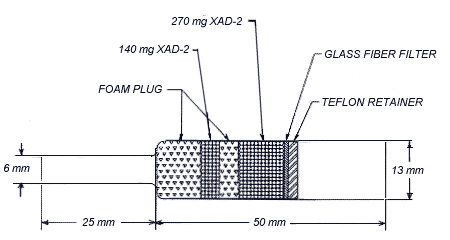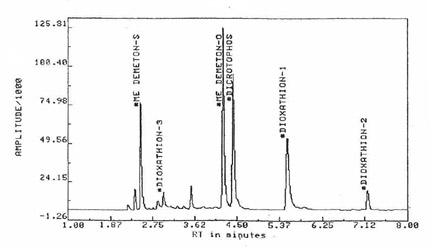1. General Discussion
1.1 Background
1.1.1 History of procedure This
evaluation was undertaken to determine the effectiveness of the OVS-2
tube as a sampling device for dicrotophos. It follows the procedure
developed for several other organophosphorus pesticides. (Ref.
5.1)
1.1.2 Toxic effects (This section is for
information only and should not be taken as the basis of OSHA
policy).
The following paragraph is excerpted from the
book OCCUPATIONAL DISEASES, A Guide To Their
Recognition. (Ref.
5.2)
The organic phosphorus compounds act
as irreversible inhibitors of cholinesterase, thereby allowing the
accumulation of large amounts of acetylcholine. When a critical
level of cholinesterase depletion is reached, usually about 20% of
normal, symptoms and signs of acetylcholine accumulation poisoning
become manifest. Symptoms may include blurred vision, weakness,
nausea, headache, abdominal cramps, chest discomfort, and diarrhea.
Signs may include miosis, muscle twitching, salivation, sweating,
tearing, cyanosis, convulsions, and coma.
Besides being absorbed following
inhalation or ingestion, organophosphorus pesticides are readily
absorbed through the intact skin (Ref
5.2). When a particular pesticide has a low dermal
LD50, a skin notation should be added to the TLV or
PEL.
Dicrotophos has an acute oral LD50 of 16 to 21 mg/kg for
rats and an acute dermal LD50 of 42 to 43 mg/kg for rats. (Ref.
5.3)
Due to these and other factors the ACGIH has
established a TLV-TWA of 0.25 mg/m3, with a skin notation,
for dicrotophos. (Ref.
5.4)
In March 1989, OSHA adopted this same value as its
PEL.
Editorial Note: These March 1989 PELs were vacated on July 7,
1992 and ceased to be enforceable on March 23, 1993 (FR
58:35338-35351, 6/30/1993).
1.1.3 Potential workplace
exposure No estimate of worker exposure to dicrotophos could be
found. Dicrotophos is used as a contact and systemic insecticide. (Ref.
5.5)
1.1.4 Physical properties (Ref.
5.3-5.5)
Molecular
weight:
Molecular formula:
CAS #
IMIS #
Boiling
point:
Vapor pressure:
Appearance:
Solubility:
Synonyms:
Chemical name:
|
237.21
C8H16NO5P
141-66-2
0902
400°C
no information found
brown liquid
(commercial grade)
miscible with water and many organic
solvents (i.e., acetone, alcohol, xylene and isobutanol)
Bidirl, Bidrin, C 709, Carbicron, Diapadrin, Ektafos, ENT
244842, SD 3562
dimethyl
cis-2-dimethyl-carbamoyl-1-methylvinyl phosphate |
| Structure: |
 | 1.2 Limit defining parameters
The detection
limit of the analytical procedure is 0.13 ng per injection. This is the
amount of analyte which will give a peak whose height is approximately
five times the baseline noise. This detection limit takes into account a
split ratio of 13.4 to 1 used on the capillary GC.
2. Sampling Procedure
2.1 Apparatus
2.1.1 A personal sampling pump
that can be calibrated to within ±5% of the recommended flow rate with
the sampling device in line.
2.1.2 OVS-2 tubes,
which are specially made 13-mm o.d. glass tubes that are tapered to
6-mm o.d. They are packed with a 140-mg backup section and a 270-mg
sampling section of cleaned XAD-2. The backup section is retained by
two foam plugs and the sampling section is between one foam plug and a
13-mm diameter glass fiber filter. The glass fiber filter is held next
to the sampling section by a polytetrafluoroethylene (PTFE)
retainer.

OVS tubes | 2.2
Reagents
No sampling reagents are required.
2.3
Sampling technique
2.3.1 Attach the small end of
the OVS-2 sampling tube to the
sampling pump with flexible,
plastic tubing such that the large, front section of the sampling tube
is exposed directly to the atmosphere. Do not place any tubing in
front of the sampler.
2.3.2 Attach the sampler
vertically (large end down) in the worker's breathing zone in such a
manner that It does not impede work
performance.
2.3.3 After sampling for the
appropriate time, remove the sampling device and seal the tube with
plastic end caps.
2.3.4 Wrap each sample end-to-end
with an OSHA seal (Form 21).
2.3.5 Submit at least
one blank with each set of samples. Handle the blank the same as the
other samples, but do not draw air through
it.
2.3.6 Submit at any bulk samples in a separate
container. Do not ship them with the air samples.
2.4 Desorption
efficiency
A glass fiber filter and an amount of XAD-2
adsorbent equal to the sampling section (270 mg) of an OVS-2 tube were
placed in each of six 4-mL vials. These vials were then sealed with
PTFE-lined septa.
Five of these vials were then each liquid
spiked with 27 µL of a 4.37 mg/mL solution of dicrophotos in toluene by
injecting through the septum onto the glass fiber filter. After
replacing the punctured septums, these vials were allowed to equilibrate
overnight in drawer at room temperature. They were then desorbed with
2.0 mL of toluene containing triphenyl phosphate (TPP) as an internal
standard and analyzed as in Section 3.5.
Table
2.4
Desorption Study
|
|
| Vial #
| Amount spiked
| Amount recovered
| % Recovery |
|
EX 1
EX
2
EX 3
EX 4
EX 5
EX 6 |
118.0
µg
118.0 µg
118.0 µg
118.0 µg
118.0 µg
0.00 µg |
109.5
µg
107.6 µg
106.1 µg
103.8 µg
102.9 µg
0.00 µg |
92.8
91.2
89.9
88.0
87.2
Blank |
|
| Average
recovery is 89.8% |
2.5 Retention
efficiency
Six OVS-2 tubes were each liquid spiked with 27 µL of
a 4.37 mg/mL solution of dicrotophos in toluene by spiking the glass
fiber filter. These tubes were then sealed with plastic end caps and
placed in a drawer at room temperature. After overnight storage, 480
liters of humid air (approximately 70% relative humidity) were drawn
through each tube. Three of these tubes, along with a blank tube, were
then desorbed and analyzed as in Section 3. No dicrotophos was found on
the backup sections of these tubes.
Table
2.5
Retention Efficiency Study
|
|
| Tube #
| Amount spiked
| Amount recovered
| % Recovery |
|
RET
1
RET 2
RET 3
RET 4 |
118.0
µg
118.0 µg
118.0 µg
0.00 µg |
107.9
µg
106.8 µg
110.7 µg
0.00 µg |
91.4
90.5
93.8
Blank |
|
| Average
recovery is 91.9% |
2.6 Sample
Storage
The remaining three spiked tubes from Section 2.5
(and a blank tube) were stored for a total of 8 days in a drawer at room
temperature. They were then desorbed and analyzed as in Section 3. No
dicrotophos was found in the backup sections of these tubes.
Table
2.6
Storage Study
|
| Tube #
| Amount spiked
| Amount recovered
| % Recovery |
|
ST 1
ST
2
ST 3
ST 4 |
118.0
µg
118.0 µg
118.0 µg
0.00 µg |
111.9
µg
104.0 µg
106.7 µg
0.00 µg |
94.8
88.1
90.4
Blank |
|
| Average
recovery is 91.1% |
2.7 Recommended air volume and sampling
rate
2.7.1 The recommended air volume is
480 L.
2.7.2 The recommended flow rate is 1.0
L/min. 2.8 Interferences
(sampling)
It is not known if any compounds will interfere with
the collection of dicrotophos. Suspected interferences should be
reported to the laboratory with submitted samples.
2.9. Safety
precautions (sampling)
2.9.1 Attach the sampling equipment in
such a manner that it will not interfere with work performance or
employee safety.
2.9.2 Follow all safety practices that
apply to the work area being sampled.
3. Analytical
procedure
3.1 Apparatus
3.1.1 A GC equipped with a FPD.
A Hewlett-Packard 589OA GC (capillary) equipped with both an FPD
operating in the phosphorus mode and a Hewlett-Packard 7673A automatic
sampler was used in this evaluation.
3.1.2 A GC
column capable of separating dicrotophos from any interference. A 45-m
× 0.2-mm i.d. SE-54 capillary column, 0.25 µm thick film, was used in
this evaluation and is available from Supelco, Inc., Bellefonte,
PA.
3.1.3 A electronic integrator or other suitable
means of measuring detector response. A Hewlett-Packard 3392A
Integrator and a Hewlett-Packard 3357 data system were used in this
evaluation.
3.1.4 Vials, 4-mL and 2-mL glass with
PTFE-lined septa.
3.1.5 Volumetric flasks,
pipets, and syringes. 3.2
Reagents
3.2.1 Hydrogen, air, and nitrogen, GC
grade.
3.2.2 Toluene, Pesticide grade.
3.2.3
Dicrotophos. A 95% pure standard from EPA was used in this
evaluation.
3.2.4 Triphenyl phosphate (TPP), practical
grade from J.T. Baker. if an internal standard method is used, the
desorbing solution is prepared by adding the internal standard to the
toluene. A 40 µg/mL solution of TPP was used as the internal standard
in this evaluation. 3.3 Standard
preparation
Prepare stock standards by adding either toluene or
desorbing solution (if an internal standard is used) to preweighed
amounts of dicrotophos. Prepare working range standards by diluting
stock solutions with either toluene or desorbing solution (if
an internal standard is used). Store stock and dilute standards in
a freezer.
3.4 Sample preparation
3.4.1 Transfer the 13-mm glass
fiber filter and the 270-mg sampling section of the tube to a 4-mL
vial. Place the first foam plug and the 140-mg backup section in a
separate vial. A small glass funnel can be used to facilitate the
transfer of the adsorbent. Discard the rear foam plug. Do not discard
the glass sampling tube, it can be reused.
3.4.2
Add 2.0 mL of either toluene or desorbing solution (if an internal
standard is used) to each vial.
3.4.3 Seal the
vials with PTFE-lined septa and allow them to desorb for one hour.
Shake the vials by hand periodically during this
time.
3.4.4 If necessary, transfer aliquots of the
samples to the vials used in GC analysis. In this evaluation the
samples were transferred to 2-mL glass vials, sealed with
PTFE-lined septa and loaded on the automatic sampler.
3.5 Analysis
3.5.1 Analytical conditions (These
conditions were developed for a series of organophosphorus pesticides,
which was run in several groups. See Figure 2. for the group
containing dicrotophos.) GC conditions
GC
column:
Carrier gas:
Flow rate:
Split
ratio:
Retention time: |
45-m × 0.2-mm i.d. SE-54, 0.25 µm thick
film
hydrogen
2.05 mL/min at 220°C
13.4 to 1 at
220°C
4.40 min |
Injector conditions
Temperature:
Volume: |
250°C
1
µL |
Oven
temperature program
Initial
temperature:
Initial time:
Rate:
Final
temperature:
Final time: |
220°C
5
min
15°C/min
260°C
15
min |
FPD
conditions
Hydrogen
flow rate:
Air flow rate:
Auxiliary gas:
Flow
rate:
Temperature: |
75 mL/min
100
mL/min
nitrogen
28
mL/min
250°C |
3.5.2 Chromatogram

This chromatogram also contains other pesticides.
3.6 Interferences
(analytical)
3.6.1 Any compound having a
retention time similar to that of the analyte is a potential
interference. Generally, chromatographic conditions can be altered to
separate interferences from the analyte.
3.6.2
Retention time on a single column is not proof of chemical identity.
Analysis by an alternate GC column and confirmation by mass
spectrometry are additional means of identification.
3.7 Calculations
3.7.1 Construct a calibration curve by
plotting detector response versus standard
concentration.
3.7.2 Determine the concentration of
dicrotophos in each sample from the calibration curve. If dicrotophos
is found on the backup section, make blank corrections for each
section separately before adding the results
together.
3.7.3 Determine the air concentration by
the following formula:
| mg/m3 = |
(mg/mL in
sample)(desorption volume, mL) |
|
| (air volume,
L)(desorption efficiency,
decimal) | 3.8 Safety precautions (analytical)
3.8.1 Avoid exposure to all
standards.
3.8.2 Avoid exposure to all solvents.
3.8.3 Wear safety glasses at all times.
4. Recommendations
for Further Study
This method should be fully validated.
5.
References
5.1 Burright, D.; Method #62,
"Chlorpyrifos, DDVP, Diazinon, Malathion, and Parathion"; OSHA
Analytical Laboratory, unpublished, 1986.
5.2 "OCCUPATIONAL
DISEASES, A Guide to their Recognition"; U.S. Department of Health,
Education, and Welfare; Public Health Service, Public Health Service
Publication No. 1097, U.S. Government Printing Office: Washington, D.C.,
1964; p 245.
5.3 Windholz, H., Ed.; "Merck Index",
10th ed.; Merck and Co.: Rahway, NJ, 1983; p 449.
5.4
"Documentation of the Threshold Limit Values and Biological Exposure
Indices", 5th ed.; American Conference of Governmental Industrial
Hygienists: Cincinnati, OH, 1986; p 193.
5.5 "Farm
Chemicals Handbook"; Meister Publishing Co.: Willoughby, OH, 1986; p
C82.
|

